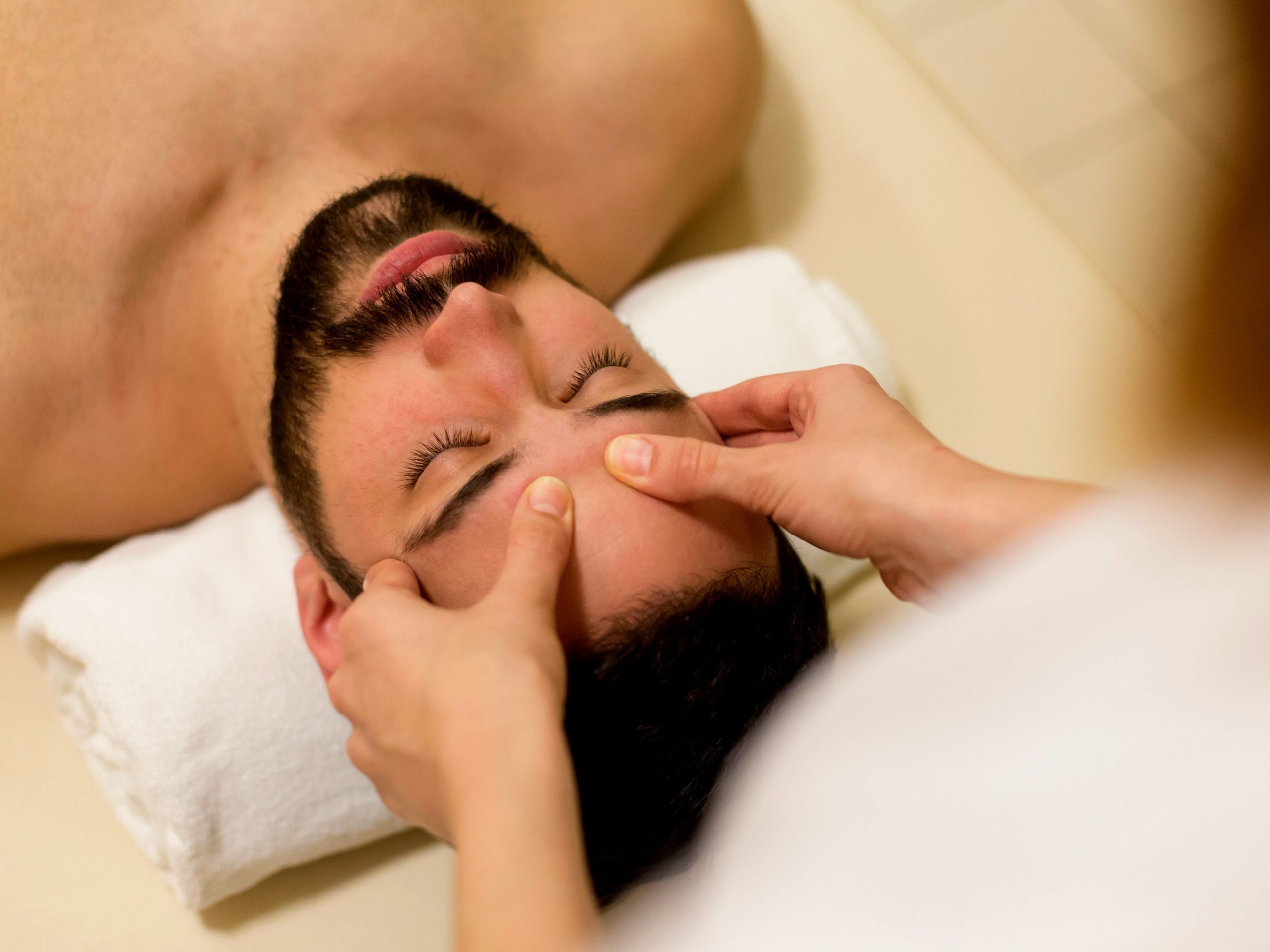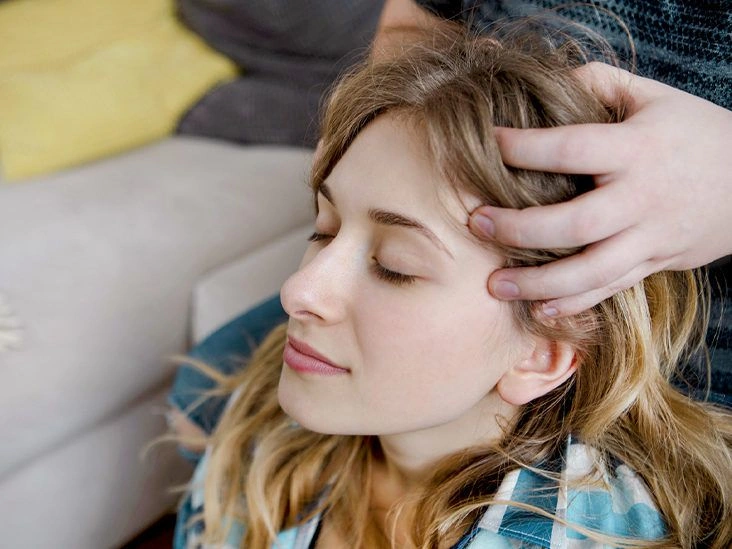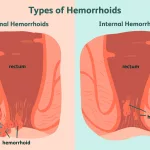Head massages can offer perks like encouraging hair growth, lowering blood pressure, and more. They may also be helpful for relieving headaches.
A head massage feels wonderful. Beyond the tactile enjoyment, it may soothe headache symptoms, reduce stress, and possibly support hair health.
The best part? You can learn to perform one at home or seek out a massage therapist for a professional treatment.

Continue reading to discover the advantages of a head massage, step-by-step self-massage instructions, and what to anticipate from a professional scalp massage.
Benefits of a head massage
Sarah Monreal, a licensed massage therapist and owner of Wayfare Wellness, explains that the benefits depend on the specific kind of head massage performed.
For instance, she practices cranial-sacral therapy, a delicate technique that concentrates on the central nervous system encompassing the skull, spinal column, and sacrum.
This style of head massage is commonly used to:
- release muscular tension
- alleviate migraine and headache discomfort
- lower stress
- encourage deep relaxation
That said, Monreal notes that even simpler massages—like the ones you might do at home—can help ease stress and tightness, nourish the scalp, and boost circulation in the head and neck area.
Below are several other advantages associated with head massages.
Head massages and headaches
Many people turn to massages of the head, neck, and shoulders as a natural approach to soothe headaches and migraine episodes.
Per the American Massage Therapy Association, methods such as deep tissue massage, trigger point therapy, self-massage, and acupressure can ease tension-type headaches by relaxing overworked muscles and decreasing pain.
While targeted research specifically on head massages for headaches is limited, some studies indicate that massage therapy—especially when aimed at certain areas in the upper neck and occipital region—may lower both the frequency and severity of headaches.
For example, in a study focusing on myofascial trigger points (MTrPs) in the upper neck and back of the head using trigger point release (TPR) massage, investigators observed a decline in headache frequency and intensity, suggesting MTrPs may contribute to tension headaches and that TPR can be effective.
Additionally, a review of manual and manipulative therapies for tension-type headaches reported notable decreases in headache pain, occurrence, and severity, along with better neck mobility, indicating these approaches may complement conventional treatments.
Another review on chronic tension headaches found that massage aimed at neck and shoulder muscles reduced headache frequency, although it did not significantly change headache intensity, implying that massage may be more consistent at decreasing how often headaches occur than at reducing how severe they are.
May promote hair growth
If you’re noticing thinner hair or less density than before, a scalp massage might be worth trying.
In a small study, participants experienced increased hair thickness after performing daily scalp massages for 24 weeks.

Lowers blood pressure
It’s well known that a scalp massage can help dissolve the day’s tension and foster relaxation.
One study also found that both 15- and 25-minute scalp massages lowered systolic and diastolic blood pressure in female participants.
The researchers propose this effect may stem from improved blood circulation prompted by the massage, which can positively influence the relaxation of blood vessels and neck muscles.
How to do a head massage
The great thing about head massages is you can do them yourself. All you really need are your fingertips—oil is optional.
If you prefer, you can use a scalp-massaging device instead of your fingertips. These come as brushes or handheld silicone tools and can be moved over the scalp similarly to how you’d use your fingers.
To give yourself a head massage, follow these steps:
- Sit in a comfortable chair. If you’re using oil, place a towel around your neck and on the chair to catch any drips.
- Begin with light to medium pressure using your fingertips or a massage tool. If using oil, dip fingers in oil before starting.
- Move across your scalp with small circular motions.
- Massage for at least 5 minutes, ensuring you cover the entire scalp.
- You can shampoo out any oil afterward.
Scalp massages are also a lovely way to connect with a partner. Try these pointers from Monreal when massaging each other at home:
- Have your partner recline or sit comfortably. If using essential oils, start with a few drops and always dilute them in a carrier oil (such as jojoba or almond). Dip your fingertips lightly into the diluted oil.
- Begin with slow, gentle strokes across the scalp, then progress to soft circular motions covering the entire head.
- Use your thumbs to provide a gentle massage to the base of the skull and the neck as well.
What are the best oils to use for a head massage?
While a head massage can be effective without oil, many people enjoy the scent and extra benefits that essential and carrier oils provide.
Although you can pick nearly any oil you like, certain oils typically pair well with scalp massage.
“We love to use essential oils whenever possible,” Monreal says. “Two of our favorites for head work are lavender and peppermint, though coconut oil is a nice option if you prefer.” Coconut serves as a carrier oil for diluting essential oils. Jojoba and sweet almond oil are other popular carrier options.
Kathy Sadowski, MS in aromatherapy and a registered aromatherapist, recommends jojoba or sweet almond for scalp massage because they’re less likely to clog pores.
Although research points to potential benefits, the FDA doesn’t oversee the purity or quality of essential oils. Talk with a healthcare provider before using essential oils, and research the quality of a brand’s products. Always perform a patch test before applying a new essential oil widely.
Trying a new essential oil on a large skin area? Do a patch test first. Here’s how:
- Clean your forearm with a mild, unscented soap, then dry it gently.
- Apply a few drops of the diluted essential oil to a small patch on your forearm.
- Cover the spot with a bandage and keep it dry for 24 hours. If you see signs of an allergic response—rash, irritation, or discomfort—remove the bandage, wash the area with soap and water, and stop using the oil. If no irritation appears after 24 hours, the oil is likely safe to use.
If you are pregnant or breastfeeding, review the pregnancy guidelines from the International Federation of Professional Aromatherapists (IFPA) to avoid oils that might be problematic.
What to expect from a professional head massage
Doing a head massage yourself is simple and inexpensive. Still, sometimes you may prefer a trained therapist to provide the treatment.
If you’re considering a professional scalp massage, here are a few things to know before booking.
“When you seek out a professional cranial-sacral massage, you can anticipate a very calming and restorative experience,” Monreal says. During the session, the therapist will concentrate on gentle strokes across the skull and neck.
Monreal notes they may also gently manipulate skull and spinal bones to normalize cerebrospinal fluid flow in the central nervous system.
“When that flow is more balanced, the cerebrospinal fluid can better support the body’s innate healing processes,” she explains.
Monreal adds a professional session typically runs about 45 minutes to an hour. “Throughout the appointment, you’ll communicate with your therapist to ensure your needs are being met appropriately,” she says.
At Monreal’s practice, a 45-minute cranial-sacral session may cost around $60.
Pricing varies by location, so check with the therapist about rates before scheduling.
The bottom line
Head massages deliver multiple benefits, whether you use your own fingertips or receive care from a professional.
A head massage can help lower stress and ease tension. It may also relieve migraine or headache symptoms, reduce blood pressure, enhance circulation in the head and neck, and encourage hair growth.
Always dilute essential oils and perform a patch test prior to broad application. If you are pregnant or nursing, consult guidance on which oils to avoid.
For guided techniques to ease migraine symptoms specifically, see migraine head massage migraine relief, and for general information on the advantages of head massage, check out head massage benefits.


















Leave a Reply
You must be logged in to post a comment.